Mitac Digital Technology AVIC-S1 PERSONAL NAVIGATION DEVICE User Manual
Mitac International Corporation PERSONAL NAVIGATION DEVICE
USERS MANUAL

AVIC-S1
User Manual
格式化: 縮排: 左 8 字元
刪除:
刪除:
Trademarks
The Bluetooth word mark and logo are owned by the Bluetooth SIG, Inc. All
other brand and product names are trademarks or registered trademarks of their
respective companies.
Note
The information in this document is subject to change without notice.

i
Table of Contents
Notice....................................................................................................iii
1 Getting Started ...............................................................................1
1.1 Understanding Hardware Features .................................................. 1
Front Components ........................................................................... 1
Back Components............................................................................ 2
Right-Side Components................................................................... 3
Top Components ............................................................................. 3
Bottom Components ........................................................................ 4
1.2 Performing the Initial Startup............................................................ 5
1.3 Connecting to AC Power and Charging the Battery ......................... 6
1.4 Turning Your Device On and Off...................................................... 7
1.5 Main Menu....................................................................................... 7
1.6 Navigating on the Screen................................................................. 8
1.7 Using a SD Card.............................................................................. 8
2 Bluetooth HF Phone.......................................................................9
2.1 About Bluetooth HF Phone .............................................................. 9
2.2 Connecting a Bluetooth Mobile Phone............................................. 9
2.3 Starting Bluetooth Mobile Phone.................................................... 10
2.4 Placing a Call................................................................................. 11
Keypad........................................................................................... 11
Contacts......................................................................................... 12
Call History .................................................................................... 13
Redial............................................................................................. 14
2.5 Operations During a Call................................................................ 14
2.6 Receiving a Call............................................................................. 15
2.7 Connecting to a Paired Phone ....................................................... 16
2.8 Initiating Pair Mode ........................................................................ 16
2.9 Closing Bluetooth HF Phone.......................................................... 17
2.10 Ending the Bluetooth Connection................................................... 17

ii
3 Troubleshooting and Maintenance.............................................18
3.1 Resetting Your System .................................................................. 18
3.2 Troubleshooting ............................................................................. 19
Power Problems............................................................................. 19
Screen Problems ........................................................................... 19
Connection Problems..................................................................... 20
GPS Problems............................................................................... 20
3.3 Maintaining Your Device................................................................ 21

iii
Notice
z Read “Important Information for the User” (a separate manual) before using
this product.
z This manual provides hardware and Bluetooth® information. For
information on the GPS navigation software, see the “Operation Manual.”
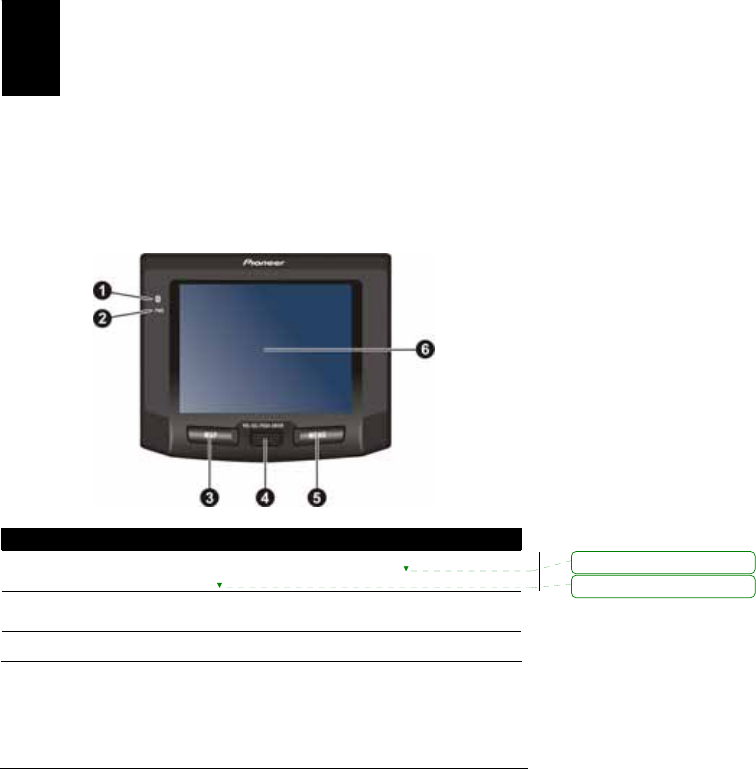
1
1 Getting Started
1.1 Understanding Hardware Features
Front Components
Ref Component Description
n Bluetooth
Indicator Flashes in blue to indicate that Bluetooth is on. The
Bluetooth is always on when your device is turned on.
o Power
Indicator Glows bright amber to indicate that the battery is charging,
and turns green when the battery is fully charged.
p Map Button Switches to the map screen.
刪除: radio
刪除: radio
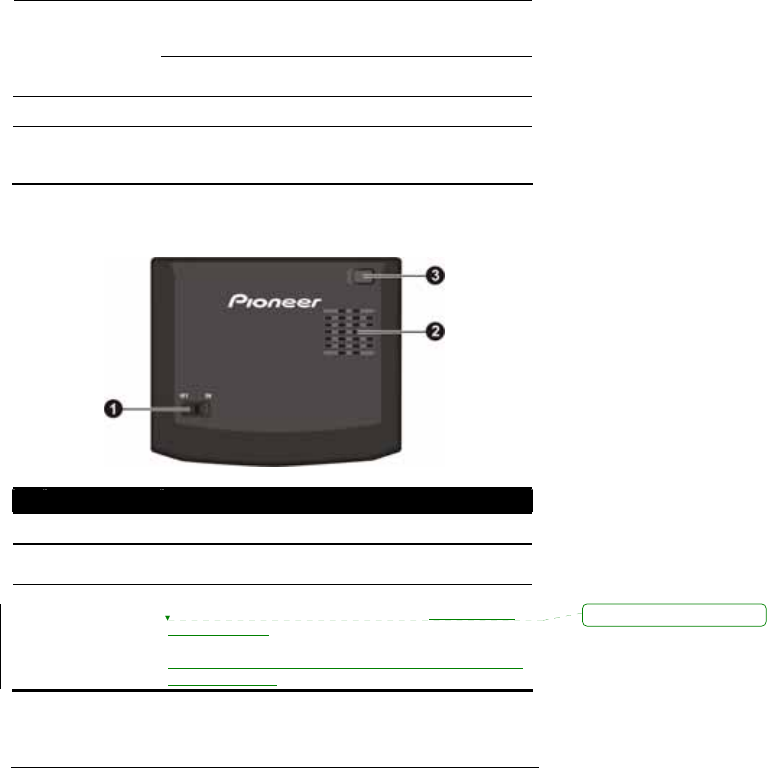
2
In a list or in Phone Menu:
Scrolls through the list or menu buttons by rotating the
wheel. Select the highlighted item by pressing in the wheel.
q Scroll Wheel
In other screens:
Adjusts the volume by rotating the wheel.
r Menu Button Opens the Main Menu.
s Touch Screen Displays the output of your device. Touch the screen with
your fingertip to select menu commands or enter
information.
Back Components
Ref Component Description
n ON/OFF Switch The main power/battery cutoff switch.
o Speaker For voice prompts, system operation tone, and hands free
dial voice.
p External GPS
Antenna This connector (under rubber dust cover) allows use of an
external GPS antenna with magnetic mount (not available
through Pioneer), which may be positioned on top of the car
for better signal reception in areas with poor reception.
Contact Pioneer Support for recommendations on available
3rd party products.
刪除: optional
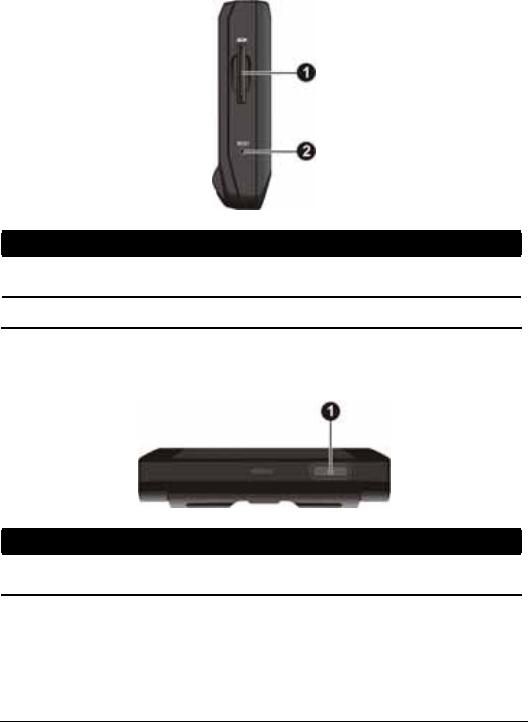
3
Right-Side Components
Ref Component Description
n SD Slot Accepts an SD (Secure Digital) card for future map and
software upgrades.
o Reset Button Restarts your device (soft reset).
Top Components
Ref Component Description
n Power Button Turns the device on and off by pressing for at least 2
seconds.
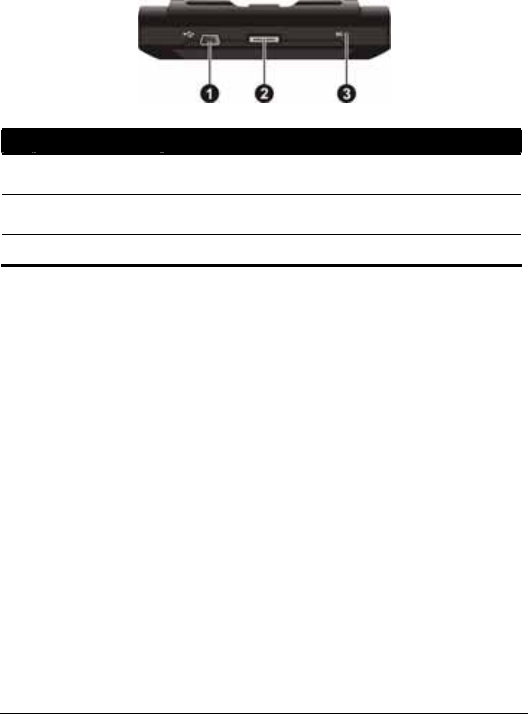
4
Bottom Components
Ref Component Description
n Mini-USB
Connector Connects to the AC adapter or USB cable.
o Car Kit
Connector Connects to the TMC Kit (European model only).
p Microphone For Bluetooth hands-free calling.
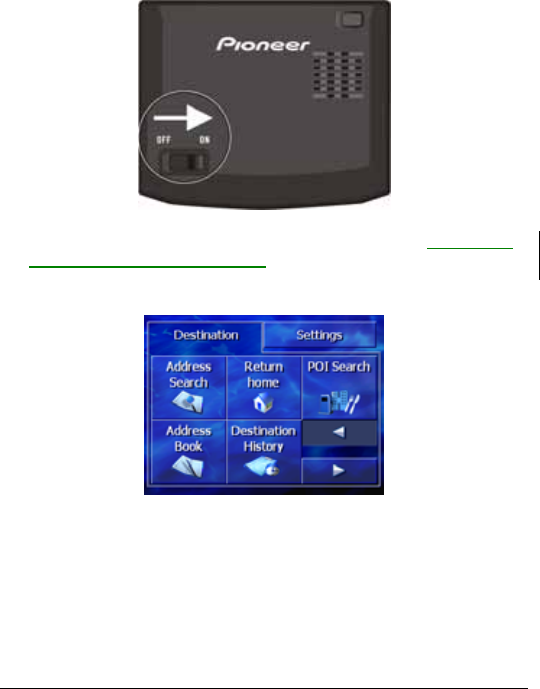
5
1.2 Performing the Initial Startup
1. Slide the ON/OFF switch to the ON position.
2. Your device turns on and displays a warning screen. Tap OK after you have
read the entire warning, and if you agree.
3. The Main Menu appears.
4. Before using your device for the fist time, connect the AC adapter as
described in the next section to fully charge the device.
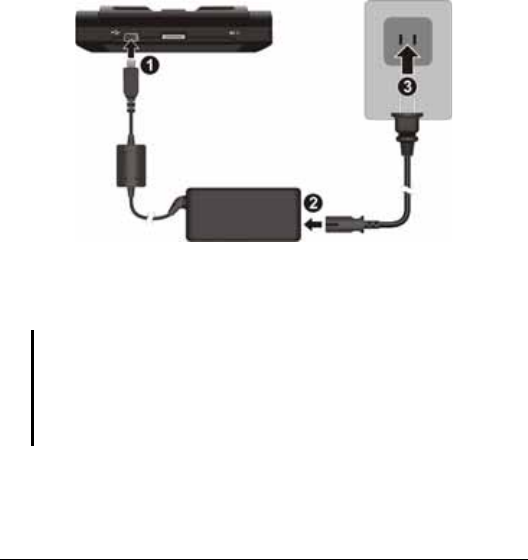
6
1.3 Connecting to AC Power and Charging the
Battery
When charging the battery for the very first time, you should charge it for at
least 8 hours.
1. Connect the AC adapter cable to the mini-USB connector on your device.
2. Connect one end of the power cable to the AC adapter and the other end to a
wall outlet.
The charge indicator glows amber when charging is in progress. Do not
disconnect your device from AC power until the battery is fully charged. The
charge indicator will turn green. This will take a couple of hours.
CAUTION: For optimal performance of the lithium battery, take note of the following:
z Do not charge the battery where the temperature is high (e.g. in direct sunlight).
z There is no need to fully discharge the battery before charging. You can charge the
battery before it is discharged.
z If you will not use the product for a long period of time, be sure to fully charge the
battery at least once every two weeks. Over discharge of the battery can affect the
charging performance.
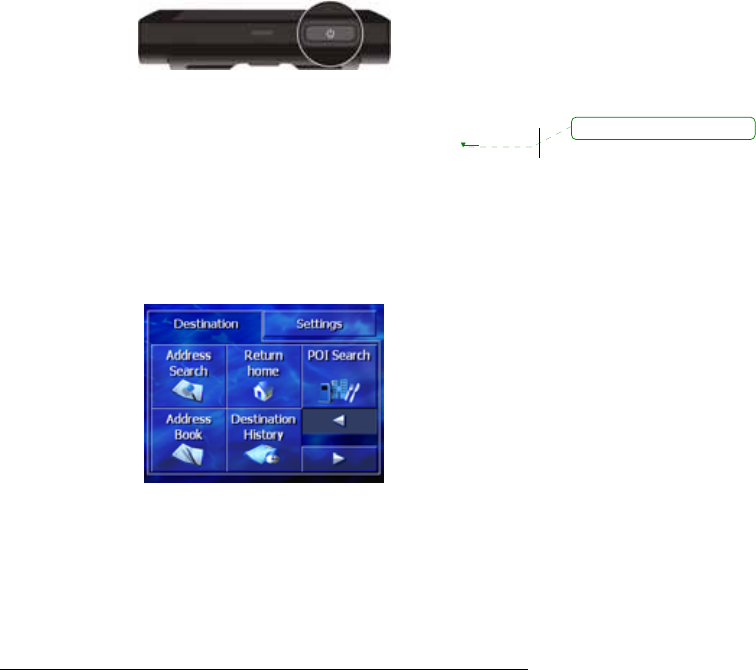
7
1.4 Turning Your Device On and Off
Press and hold the power button for at least 2 seconds to turn on and off your
device.
When you press the power button to turn off the unit, your device actually enters
into a suspend state and the system stops operating. Once you turn on the system
again, it resumes from the same guidance or menu screen you left off at.
1.5 Main Menu
The Main Menu is your starting place for various tasks. Tap a button to start a
task or open another menu. (For information on the GPS navigation software,
see the document supplied with the software. For information on the Phone
Menu, see the next chapter.)
You can access the Main Menu at any time by pressing the MENU button on
your device.
刪除: at .
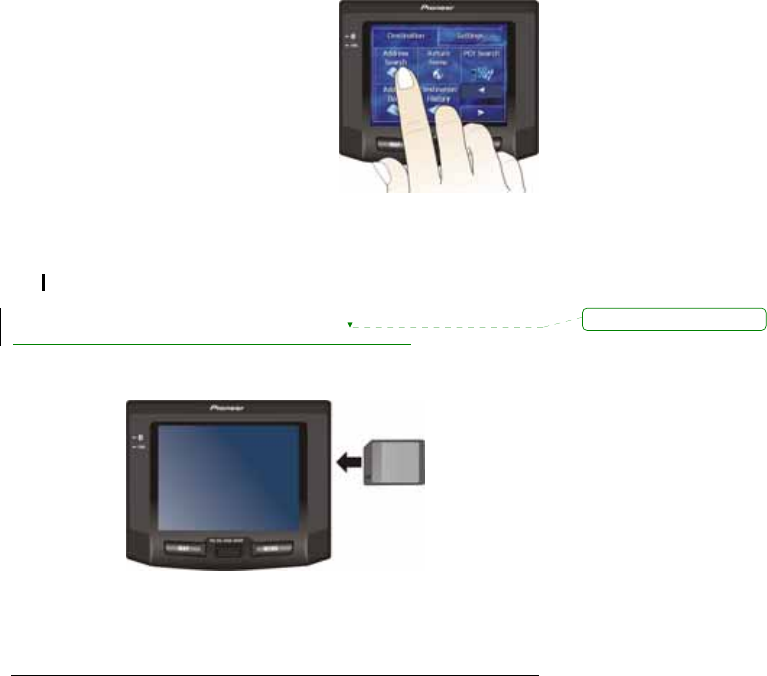
8
1.6 Navigating on the Screen
To navigate and select objects on the screen, simply use your finger and touch
the screen. The following are possible via touch screen:
z Tap
Touch the screen once with your finger to
open items or select options.
z Drag
Hold your finger on the screen and drag
up/down/left/right or across the screen.
z Tap and hold
Tap and hold your finger until an action is
complete, or a result or menu is shown.
1.7 Using a SD Card
NOTE: Make sure that no foreign objects enter the slot.
Your device has a SD slot where you can insert an Secure Digital storage card
for future software and application upgrades sold by Pioneer. To use a SD card,
insert it into the slot, with the connector pointing to the slot and its label facing
the front of the device.
To remove a card, first make sure that no application is accessing the card, and
then slightly push the top edge of the card to release it and then pull it out of the
slot.
刪除: optional

9
2 Bluetooth HF Phone
2.1 About Bluetooth HF Phone
Your device can serve as a hands-free (HF) device for a Bluetooth mobile
phone. After establishing the Bluetooth connection, you can tap your device to
place and receive phone calls instead of picking up the mobile phone, and can
use the built-in speakers and microphone for your conversation.
2.2 Connecting a Bluetooth Mobile Phone
To connect with a Bluetooth mobile phone for the first time:
1. Initiate the Bluetooth searching process on your mobile phone. You should
see “Pioneer AVIC-S1” in the device list after searching is completed.
2. Select “Pioneer AVIC-S1” to create the connection. Use the 0000 default
passkey to connect.
3. Your AVIC-S1 can now serve as a hands-free device for your mobile
phone.
刪除: device
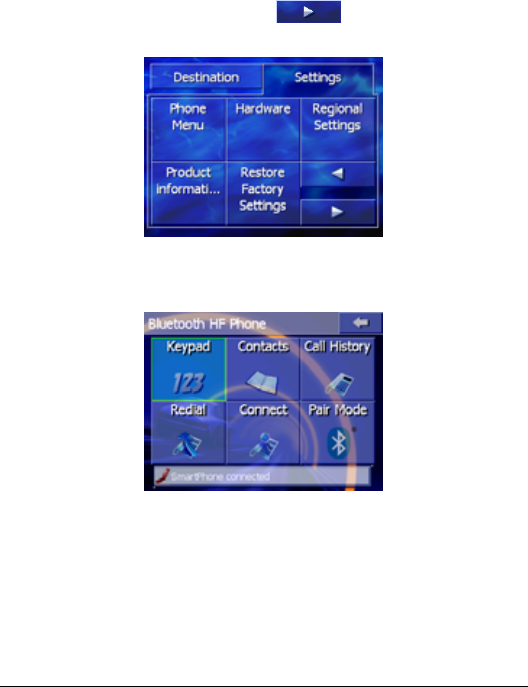
10
2.3 Starting Bluetooth Mobile Phone
1. Press and hold the MENU button on your device for at least 2 seconds.
- or -
Tap Settings on the Main Menu. Tap twice and then tap Phone
Menu.
2. The Bluetooth HF Phone main screen appears. The status bar at the bottom
shows the name of the mobile phone connected.
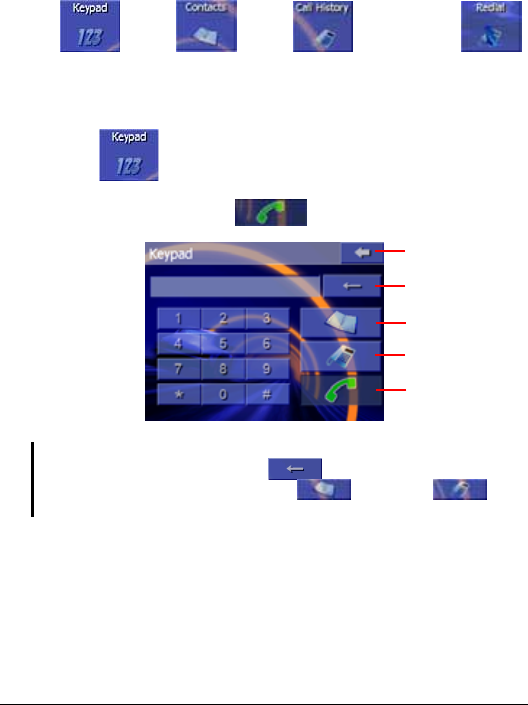
11
2.4 Placing a Call
After pairing with your mobile phone, you can place a call using any of the four
buttons ( Keypad, Contact, Call History, and
Redial) on the Bluetooth HF Phone main screen.
Keypad
By tapping the Keypad button on the Bluetooth HF Phone main
screen, you can enter the telephone number with the onscreen keypad. After
entering the telephone number, tap to place the call.
NOTE:
z To delete the last digit entered, tap the Backspace button.
z The other two buttons allow you to switch to Contacts and Call
History screens.
Backspace
Back
Contacts
Call History
Call
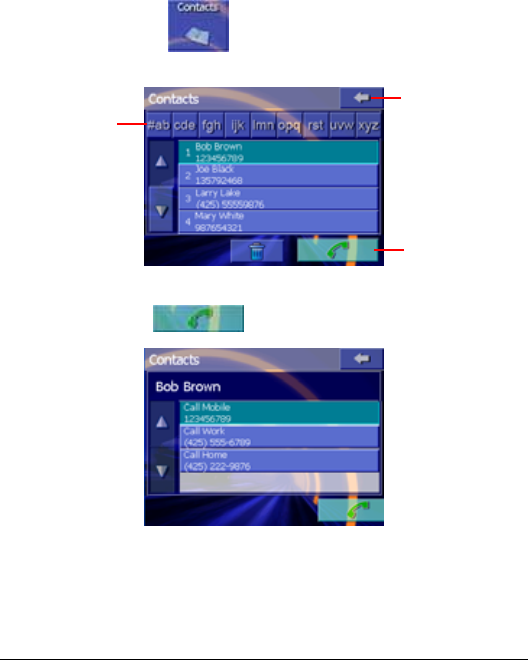
12
Contacts
You can exchange business cards between Bluetooth devices via OPP (Object
Push Profile). As long as you have sent such information to your device, the
information is available in Bluetooth HP Phone.
To call a contact, tap the Contact button on the Bluetooth HF Phone
main screen.
Tap the desired contact and the phone number list appears. Tap the phone
number to call and tap to call the selected phone number.
Index
Back
Call the selected
number.
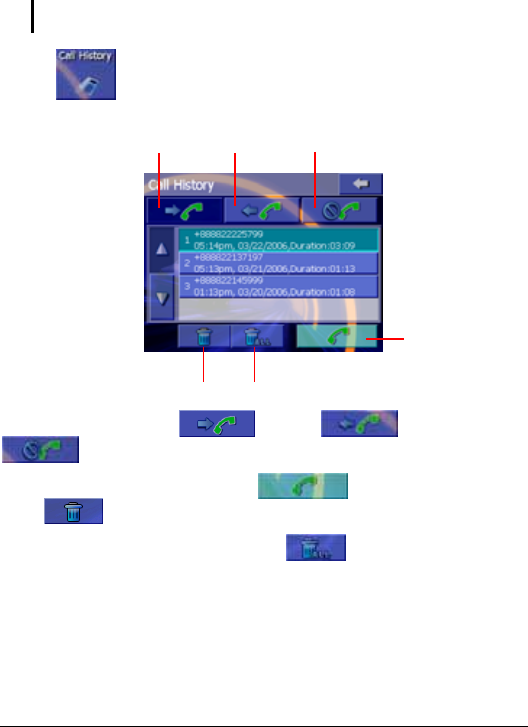
13
Call History
NOTE: Bluetooth HF Phone cannot access the call history stored in a connected mobile
phone.
Tap the Call History button on the Bluetooth HF Phone main screen to
display the recent incoming, outgoing, or missed calls together with information
such as date, time, and duration of each call.
Tap the respective button ( Incoming, Outgoing, or
Missed) to view the last 20 calls of the selected type.
With an item selected, you can tap the button to dial the number
or the button to delete the item.
To clear all items in the current list, tap the button.
Outgoing Missed
Incoming
Call
Delete Delete All

14
Redial
Tap the Redial button on the Bluetooth HF Phone main screen to dial
the last number you called or received.
2.5 Operations During a Call
During a call, four functions are available:
z If you need to input other numbers, such as an extension number, tap
to open the keypad and tap the digits. The keypad will close when you tap
the button again or when there has been no input for 5 seconds.
Switch to
mobile phone. Delete All
Cancel
Mute
End
Mute
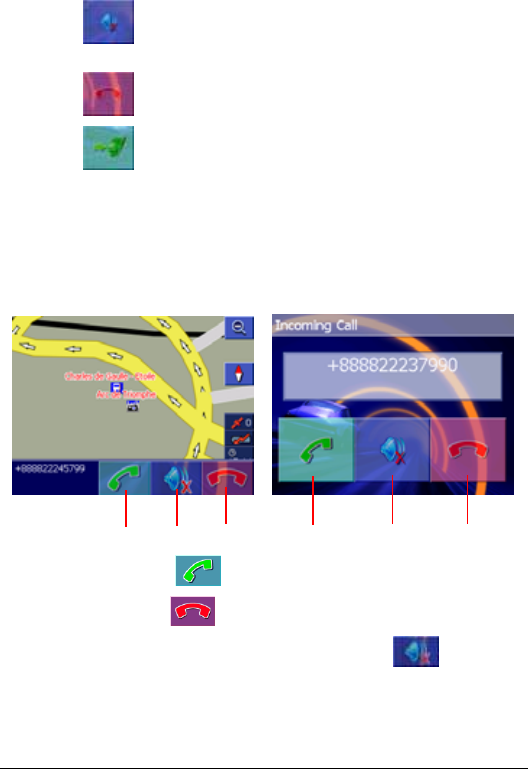
15
z Tap the Mute button to mute your sound so that the other party
cannot hear you. To end the mute mode, tap the same button again.
z Tap the Ignore button to end the call.
z Tap the Transfer button to switch the call to your mobile phone. To
switch back to your device, tap the same button again.
2.6 Receiving a Call
When you have a call after pairing with a mobile phone, the device rings and
displays the Incoming Call screen.
While in the map screen While in the Bluetooth HF Phone screen
To accept the call, tap the Answer button.
To reject the call, tap the Ignore button.
To mute the ring tone before receiving or rejecting, tap the Mute button.
Reject
Mute
A
ccept
Reject
Mute
A
ccept
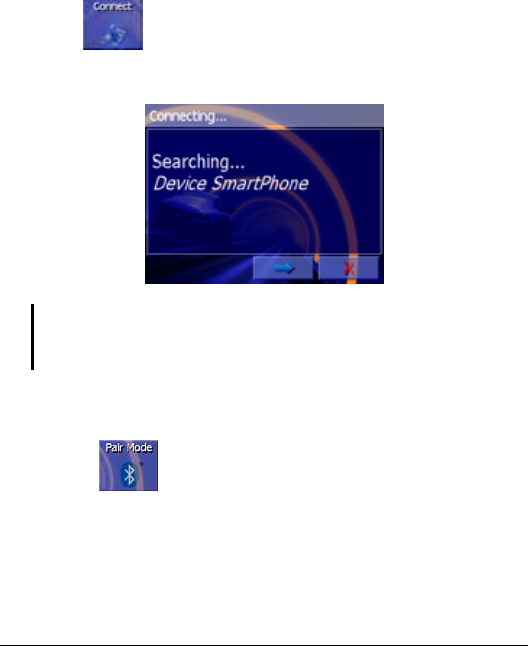
16
2.7 Connecting to a Paired Phone
Once you have established a Bluetooth connection with a mobile phone, it will
be stored in your device. You can initiate the connection from your device.
1. Start Bluetooth HF Phone as described in section 2.2
2. Tap the Connect button on the Bluetooth HF Phone main screen.
Your device will search the last paired mobile phones for an available
connection.
NOTE:
z Make sure that the mobile phone is in “discoverable” mode.
z Up to 8 sets of paired mobile phones can be stored. A 9th paired mobile phone will
replace the oldest one.
2.8 Initiating Pair Mode
By tapping the Pair Mode button on the Bluetooth HF Phone main
screen, you can manually set your device to Pair Mode. Within the duration of
60 seconds, you can initiate the pairing process on your mobile phone to
discover your device as a hands-free device.
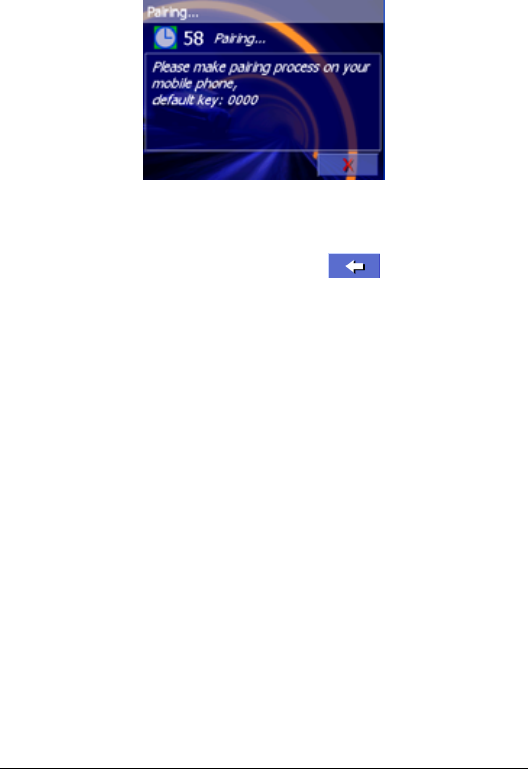
17
2.9 Closing Bluetooth HF Phone
To hide the Bluetooth HF Phone screen, tap the button on the
Bluetooth HF Phone main screen. Bluetooth HF Phone is still running in the
background.
2.10 Ending the Bluetooth Connection
When you turn off your device, the connection is ended. You can also end the
connection from your mobile phone.
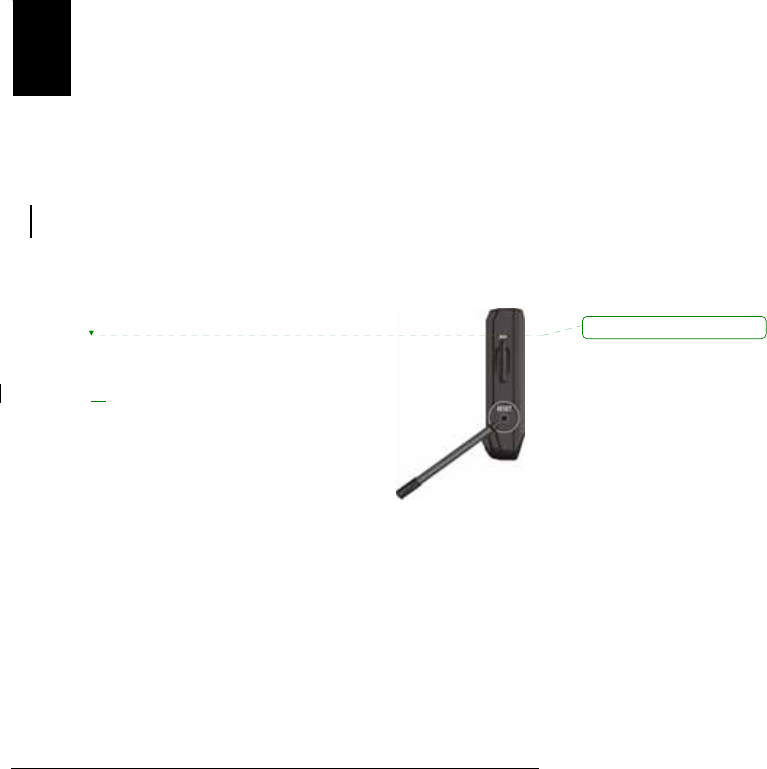
18
3 Troubleshooting and Maintenance
This chapter gives solutions to common problems you may encounter. It also
provides guidelines on how to take care of your device.
NOTE: If you encounter a problem you cannot solve, contact an authorized service center for
assistance.
3.1 Resetting Your System
1. Disconnect all cables, including the AC adapter, from your device.
2. Slide the ON/OFF switch to the OFF position.
3. Wait for 1 minute and then slide the switch back to the ON position.
Troubleshooting and
Maintenance
Occasionally, you may need to reset your device. For example,
you should reset your system when it stops responding; or
appears to be “frozen” or “locked up.”
Use the stylus pen to press the reset button on your device. This is
called a “soft reset.”
If your device still does not respond after a soft reset, you can use
the following steps to perform a “hard reset.”
刪除: e
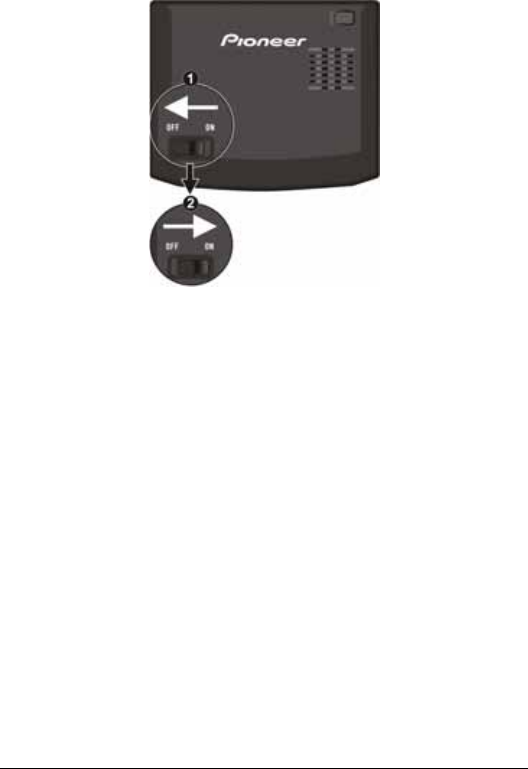
19
4. Your device turns on.
3.2 Troubleshooting
Power Problems
Power does not turn on when using battery power
z The remaining battery power may be too low to run your device. Connect
the AC adapter to your device and then to AC power. Then, turn on your
device.
Screen Problems
Screen is off
If the screen does not respond even after you press the power button, try the
following in order until the problem is solved:
z Connect the AC adapter to your device and to external AC power.
z Reset your system.

20
Screen responds slowly
z Make sure that your device is not running out of battery power. If the
problem still exists, reset your system.
Screen freezes
z Reset your system.
Screen is hard to read
z Make sure that the backlight of the display is on and if necessary adjust the
brightness. (It is weird that you talk about adjusting the brightness, but there
is no place in the manual that tells you that is under SETTINGS->
HARDWARE-> BRIGHTNESS)
Connection Problems
Cable Connection Problems
z Make sure that your device and your computer are both turned on before
trying to establish a connection.
z Make sure that the cable is securely plugged into the USB port on your
computer and on the device. Connect the USB cable directly to your
computer—do not run the cable through a USB hub.
z Reset your device before connecting the cable. Always disconnect your
device before you restart your computer.
GPS Problems
When there are no valid signals available, consider the following:
z Make sure that the device is facing a clear view of the sky.
z Note that the GPS reception can be affected by:
9 Bad weather
9 Dense overhead obstacles (e.g. trees and tall buildings)
9 Other wireless device in the car
9 Reflective car window tint and heated screens.

21
3.3 Maintaining Your Device
Taking good care of your device will ensure trouble-free operation and reduce
the risk of damage to your device.
z Keep your device away from excessive moisture and extreme temperatures.
z Avoid exposing your device to direct sunlight or strong ultraviolet light for
extended periods of time.
z Do not place anything on top of your device or drop objects on your device.
z Do not drop your device or subject it to severe shock.
z Do not subject your device to sudden and severe temperature changes. This
could cause moisture and condensation build up inside the unit, which could
damage your device. In the event of moisture or condensation, allow the
device to dry out completely before use.
z Do not place heavy objects on top of this device. Use the provided Carrying
Case when transporting the unit outside of the vehicle.
z The screen surface can easily be scratched. Avoid touching it with sharp
objects. Non-adhesive generic screen protectors designed specifically for
use on portable devices with LCD panels may be used to help protect the
screen from minor scratches.
z Never clean your device with it powered on. Use a soft, lint-free cloth
moistened with water to wipe the screen and the exterior of your device.
z Do not use paper towels to clean the screen.
z Never attempt to disassemble, repair or make any modifications to your
device. Disassembly, modification or any attempt at repair could cause
damage to your device and even bodily injury or property damage and will
void any warranty.
z Do not store or carry flammable liquids, gases or explosive materials in the
same compartment as your device, its parts or accessories.

22
FCC Regulations:
zThis device complies with part 15 of the FCC Rules. Operation is subject to
the following two conditions: (1) This device may not cause harmful
interference, and (2) this device must accept any interference received,
including interference that may cause undesired operation.
zThis device has been tested and found to comply with the limits for a Class B
digital device, pursuant to Part 15 of the FCC Rules. These limits are designed
to provide reasonable protection against harmful interference in a residential
installation. This equipment generates, uses and can radiated radio frequency
energy and, if not installed and used in accordance with the instructions, may
cause harmful interference to radio communications. However, there is no
guarantee that interference will not occur in a particular installation If this
equipment does cause harmful interference to radio or television reception,
which can be determined by turning the equipment off and on, the user is
encouraged to try to correct the interference by one or more of the following
measures:
-Reorient or relocate the receiving antenna.
-Increase the separation between the equipment and receiver.
-Connect the equipment into an outlet on a circuit different from that to which
the receiver is connected.
-Consult the dealer or an experienced radio/TV technician for help.
Changes or modifications not expressly approved by the party responsible for
compliance could void the user‘s authority to operate the equipment.
格式化: 項目符號及編號